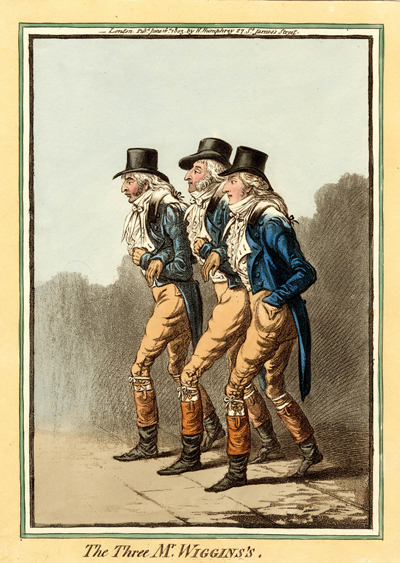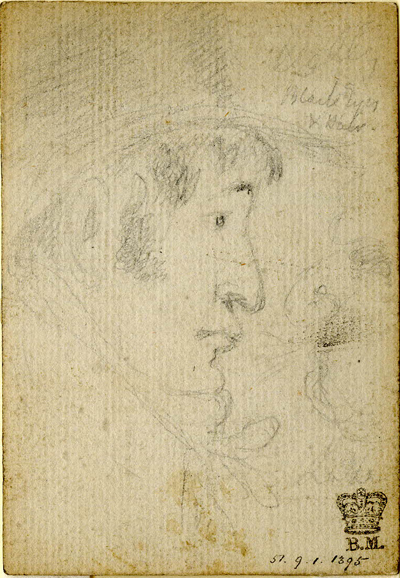The Three Mr. Wiggins's
This print features three good-looking men about town who also happen to be brothers: (left to right) the Honourable George Mathew, Viscount Francis Mathew, and Colonel Montagu Mathew. They stroll arm in arm, in perfect lockstep with left foot forward, while dressed alike at the height of fashion. According to Thomas Wright,
They wear short beaver hats with broad brims, long and flowing hair, powdered, with a "club" hanging down the back; high muslin neckcloths, great double frills, bob tailed coats with broad facings; white waistcoats, with the lappels turned over on the coat; white knee breeches, tied with a bunch of white ribbons, and top boots complete the elaborate ensemble.

© Trustees of the British Museum
As so often happens with Gillray prints, the title alludes to a current theatre production. In this case, it is a Farce by John Till Allingham called Mrs. Wiggins, which was first produced at the Theatre Royal, Haymarket in May of 1803 and was still playing when Gillray's print appeared on June 16. According to the European Magazine and London Review for June 1st, 1803:
The idea upon which it is built is truly farcical. The hero, a remarkably fat man, 'aye as fat as butter,' as Shakespeare has it, comes up from the country to avoid his wife, whose economical turn is little relished by this 'huge feeder.' His son, Tom Wiggins, who has chambers in the Temple, is married, without his father's knowledge, to a woman who has a former husband living, and has an intrigue with another woman who assumes his name; at every turn the poor fat man is haunted by a Mrs. Wiggins, and supposing it to be his wife, who has followed him to London, the name is no sooner announced than he makes his escape as fast as his belly will let him. In the end the mistake is cleared up by the appearance of the real Mrs. Wiggins.
The application of a slightly altered version of the play title to the Mathew brothers must have seemed almost too obvious, for in the small world of Bond Street fashion, a Mathew would have been popping up everyhere one looked. But the potential association was made even easier by the fact that the fat Mr. Wiggins of the farce was played by the comic actor, Charles Mathews.
The British Museum has a sketch of a man (presently unidentified) in its collection with the marginal notation "Black Eyes & Hair." It is done in pencil on the card stock Gillray often used for sketches ad vivam of the characters who later appear as caricatures in his prints. To me, it looks like a preparatory sketch for a slightly more caricatured version of George Mathew (the first Mr. Wiggins), most likely created for this print.

© Trustees of the British Museum
Sources and Reading
- Commentary from the British Museum on The Three Mr. Wiggins's.
- "Montague James Mathew," Wikipedia
- "Francis Mathew, 2nd Earl Landaff," Wikipedia
- "John Till Allingham," Wikipedia
- Thomas Wright and R.H. Evans, Historical and Descriptive Account of the Caricatures of James Gillray #525
- Thomas Wright and Joseph Grego, The Works of James Gillray, the Caricaturist; With the History of His Life and Times p. 308.
Comments & Corrections
NOTE: Comments and/or corrections are always appreciated. To make that easier, I have included a form below that you can use. I promise never to share any of the info provided without your express permission.